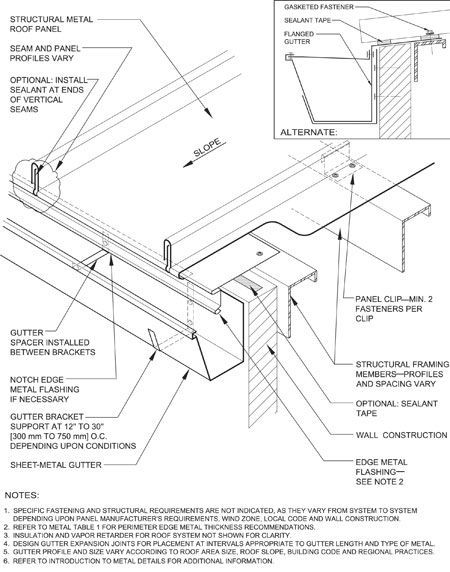Gutters are a common method for collecting and removing rainwater from low-slope structural metal panel roof systems. The NRCA Architectural Sheet Metal and Metal Roofing Manual—2006 Edition, provides five details for structural metal panel roof systems with gutters at eaves. Detail S-MTL-3B, "Downslope Flashing with Gutter with Brackets—'T' Type," provides information specific to flat-pan vertical-seam structural metal panels incorporating a T-type edge-metal flashing and gutter.
In this detail, a T-type edge metal is fastened to a structural framing member with the option of including sealant tape between the top of the wall and the edge metal. Where there are concerns that water backup or ice dams will occur, the use of sealant tape is strongly recommended. T-type edge-metal thickness and attachment method(s) should be based on anticipated uplift loads and desired resistance. A reference note guides users to a table with minimum gauge recommendations for edge metal.

Detail S-MTL-3B from The NRCA Architectural Sheet Metal and Metal Roofing Manual—2006 Edition
The flat-pan structural panels are hooked to the T-type edge metal to provide uplift resistance and weatherproofing. If panels are fixed at the eaves, no movement will occur at the eaves. If panels are fixed at the midpoint or ridge, the panels' expansion and contraction need to be accounted for. Movement generally is accommodated by increasing the length of the panel hook and width of the T-type edge metal and providing a gap that accommodates expected movement. This allows movement without damaging the panel or T-type edge metal.
The gutter is supported by gutter brackets. Gutter bracket spacing and gauge are based on anticipated loads, such as rainwater, ice and snow. Section 2.3.1—Externally Attached (Hanging) Gutters provides minimum thicknesses of gutter metal based on girth and recommendations for sizes for gutter brackets and straps based on metal type.
Gutter spacers mainly are used to help ensure a gutter retains its intended shape; however, spacers provide some—albeit minimal—load-carrying capacity.
The four other details in this series vary with respect to panel profile, gutter support, gutter attachment and eave closure.
James R. Kirby, AIA, is NRCA's associate executive director of technical communications.
COMMENTS
Be the first to comment. Please log in to leave a comment.